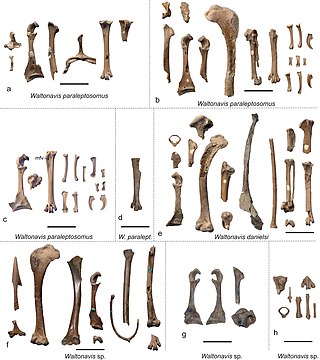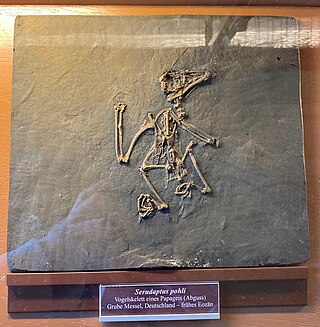
Charadriiformes is a diverse order of small to medium-large birds. It includes about 390 species and has members in all parts of the world. Most charadriiform birds live near water and eat invertebrates or other small animals; however, some are pelagic (seabirds), others frequent deserts, and a few are found in dense forest. Members of this group can also collectively be referred to as shorebirds.

Gaviiformes is an order of aquatic birds containing the loons or divers and their closest extinct relatives. Modern gaviiformes are found in many parts of North America and northern Eurasia, though prehistoric species were more widespread.

Waders or shorebirds are birds of the order Charadriiformes commonly found wading along shorelines and mudflats in order to forage for food crawling or burrowing in the mud and sand, usually small arthropods such as aquatic insects or crustaceans. The term "wader" is used in Europe, while "shorebird" is used in North America, where "wader" may be used instead to refer to long-legged wading birds such as storks and herons.

Dasornis is a genus of prehistoric pseudotooth birds. These were probably close relatives of either pelicans and storks or waterfowl; they are placed in the order Odontopterygiformes to account for this uncertainty.

Lithornis is a genus of extinct paleognathous birds. Although Lithornis was able to fly well, their closest relatives are the extant tinamous and ratites.
Eurofluvioviridavis is a genus of extinct primitive birds from the Middle Eocene Messel Pit, Germany. It contains a single species, Eurofluvioviridavis robustipes. It is related to Avolatavis and Vastanavis, other members of the family Vastanavidae.

Juncitarsus is an extinct genus of wading birds from the Eocene of the United States and Germany. Though previously considered a flamingo, it is likely a stem-flamingo, possibly a relative of the group which contains both flamingos and grebes (Mirandornithes).
Morsoravis is an extinct genus of neoavian bird from the Early Eocene Fur Formation of Denmark. It contains a single named species, Morsoravis sedilis. Fossils of Morsoravis have also been found in the Green River Formation of Wyoming and possibly the Nanjemoy Formation of Virginia.
Danielsraptor is an extinct genus of masillaraptorid bird from the Early Eocene (Ypresian) Walton Member of the London Clay Formation in Essex, United Kingdom. The genus contains a single species, D. phorusrhacoides, known from a partial skeleton.
Nasidytes is an extinct genus of loon (Gaviiformes) that lived during the early Eocene in what is now Great Britain. It contains a single species, N. ypresianus. Nasidytes is the earliest unambiguously identified loon in the fossil record.

Ypresiglaux is an extinct genus of strigiform bird from the Early Eocene London Clay Formation of Essex, United Kingdom and Nanjemoy Formation of Virginia, United States. The genus contains two species: Y. michaeldanielsi, known from a partial skeleton, and Y. gulottai, known from a distal tarsometatarsus.

Lutavis is an extinct genus of potentially afroavian bird from the Early Eocene London Clay Formation of Essex, United Kingdom. The genus contains a single species, L. platypelvis, known from a partial skeleton.

Waltonavis is an extinct genus of potentially leptosomiform bird from the Early Eocene London Clay Formation of Essex, United Kingdom. The genus contains two species: W. paraleptosomus and W. danielsi, both known from partial skeletons.

Psittacomimus is an extinct genus of psittacopedid bird from the Early Eocene London Clay Formation of Essex, United Kingdom. The genus contains a single species, P. eos, known from a partial skeleton.

Minutornis is an extinct genus of parapasserine bird from the Early Eocene London Clay Formation of Essex, United Kingdom. The genus contains a single species, M. primoscenoides, known from a fragmentary skeleton.
Pulchrapollia is an extinct genus of halcyornithid bird from the Early Eocene London Clay of Walton-on-the-Naze, United Kingdom and the Nanjemoy Formation of Virginia, United States. The genus contains three species, Pulchrapollia gracilis, Pulchrapollia tenuipes and Pulchrapollia eximia.

Serudaptus is an extinct genus of halcyornithid bird from the Middle Eocene Messel pit in Hesse, Germany. The genus contains one species, Serudaptus pohli, and is known for long, raptorial claws on its zygodactyl feet.
Parapsittacopes is an extinct genus of psittacopedid bird from the Early Eocene London Clay, United Kingdom. The genus contains one species, Parapsittacopes bergdahli.
Eofringillirostrum is an extinct species of bird known from the Early Eocene Green River Formation of the Western United States and from the Messel Pit in Germany. The genus contains two species, Eofringillirostrum boudreauxi and Eofringillirostrum parvulum. They are the earliest known fossil birds to have a finch-like beak.
Sororavis is an extinct genus of bird from the Early Eocene London Clay of Walton-on-the-Naze, United Kingdom. It contains a single named species, Sororavis solitarius. It is a member of the Morsoravidae.














